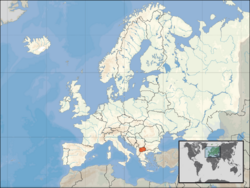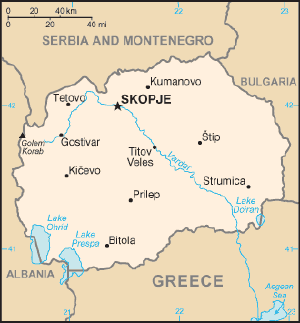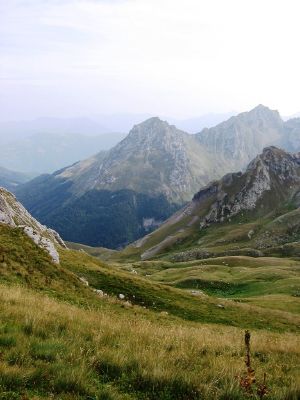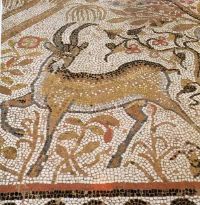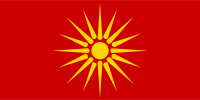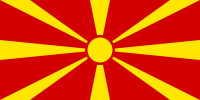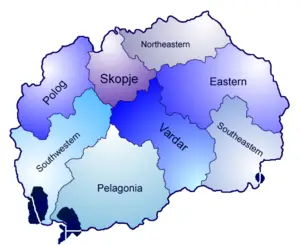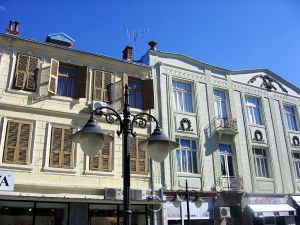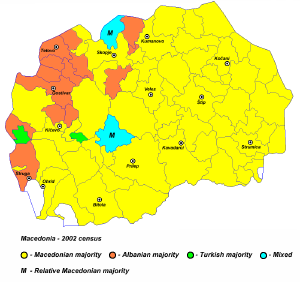North Macedonia
| Република Македонија Republika Makedonija[1] Republic of Macedonia | |||||
| |||||
| Anthem: Денес над Македонија (Macedonian) "Today over Macedonia" | |||||
| Capital | Skopje 42°0′N 21°26′E | ||||
|---|---|---|---|---|---|
| Largest city | capital | ||||
| Official languages | Macedonian, Albanian1 | ||||
| Government | Parliamentary republic | ||||
| - President | Branko Crvenkovski | ||||
| - Prime Minister | Nikola Gruevski | ||||
| Independence | from Yugoslavia | ||||
| - Declared | September 8 1991 | ||||
| Area | |||||
| - Total | 25,333 km² (148th) 9,779 sq mi | ||||
| - Water (%) | 1.9 | ||||
| Population | |||||
| - 2006 estimate | 2,038,514 [1] | ||||
| - 2002 census | 2,022,547 | ||||
| - Density | 79/km² 205/sq mi | ||||
| GDP (PPP) | 2006 estimate | ||||
| - Total | $16.94 billion | ||||
| - Per capita | $7,645 | ||||
| HDI (2004) | |||||
| Currency | Macedonian denar (MKD)
| ||||
| Time zone | CET (UTC+1) | ||||
| - Summer (DST) | CEST (UTC+2) | ||||
| Internet TLD | .mk | ||||
| Calling code | +389 | ||||
| 1 Macedonian is designated as the primary official language. As of June 2002, any language spoken by at least 20% of the population is also an official language. At present, only Albanian fulfills this requirement, but it can only be used as prescribed by law (e.g., issuing official documents, when communicating with government offices, in municipal self-government) and always in addition to Cyrillic Macedonian. In communities where over 20% of the population speak another language, that language can be used as a municipal official language along with Macedonian and any other official languages; such languages include Turkish, Serbian, Romany and Aromanian. | |||||
The Republic of Macedonia (Macedonian: Република Македонија, Republika Makedonija often referred to as Macedonia, is a landlocked country on the Balkan peninsula in southeastern Europe.
It was admitted to the United Nations in 1993; however, the UN and many other international institutions and countries use the provisional reference the former Yugoslav Republic of Macedonia (F.Y.R.O.M.), pending resolution of a naming dispute with Greece.
The country is a member of the UN and the Council of Europe and a member of La Francophonie, the World Trade Organization (WTO), and the Organization for Security and Cooperation in Europe. Since December 2005 it is also a candidate for joining the European Union and has applied for NATO membership.
Geography
The Republic of Macedonia is a landlocked country that is geographically clearly defined by a central valley formed by the Vardar river and framed along its borders by mountain ranges. It is bordered by Serbia to the north, Albania to the west, Greece to the south, and Bulgaria to the east.
With a land area of 9779 square miles (25,333 square kilometers), the Republic of Macedonia is slightly larger than the state of Vermont in the United States.
The Republic's terrain is mostly rugged, located between the Šara and Osogovo, which frame the valley of the Vardar river. Three large lakes — Lake Ohrid, Lake Prespa and Dojran Lake — lie on the southern borders of the Republic, bisected by the frontiers with Albania and Greece. Ohrid is considered to be one of the oldest lakes and biotopes in the world.
The Republic of Macedonia also has scenic mountains. They belong to two different ranges: Dinarska and Rodopska. The Dinarska range is the oldest with subsequent erosion; the Rodopska range is younger offering rugged, alpine scenery. The highest point is Golem Korab (Maja e Korabit) at 9068 feet (2764 meters).
There are three main climatic zones in the country: temperate Mediterranean, mountainous and mildly continental. The summers are hot and dry and the winters are moderately cold. Average annual precipitation varies from 67 inches (1700mm in the western mountainous area to 20 inches (500mm) in the eastern area. Snowfalls can be heavy in winter. Temperatures average 32°F (0°C) in January (winter) and rise to 68°–77°F (20°–25°C) in July (summer). The warmest region is the Demir Kapija and Gevgelija region, where the temperature in July and August frequently exceeds 104°F (40°C).
Most of Macedonia drains south-east into the Aegean Sea, via the Vardar River and its tributaries. Smaller parts drain into Lake Doiran and into the Aegean via the Strumica and Struma rivers. The remainder drains north via the Crni Drim River to the Adriatic.
Fauna include European bison, fox, rabbits, brown bears, and deer. Ducks, turtles, frogs, raccoons, while muskrats inhabit the country's waterways.
Natural resources include low-grade iron ore, copper, lead, zinc, chromite, manganese, nickel, tungsten, gold, silver, asbestos, gypsum, timber, and arable land.
The region is seismically active and has been the site of destructive earthquakes in the past, most recently in 1963 when Skopje was heavily damaged by a major earthquake, killing over 1,000. Environmental issues concern air pollution from metallurgical plants.
Skopje is the capital and largest city, with 500,000 inhabitants or more than a quarter of the population of the country, as well as the political, cultural, economical and academic centre of the country. It was known from the Roman period under the name Scupi. There are a number of smaller cities, notably Bitola, Kumanovo, Prilep, Tetovo, Ohrid, Veles, Štip, Kočani, Gostivar and Strumica.
History
The lands governed by the Republic of Macedonia were previously the southernmost part of the Socialist Federative Republic of Yugoslavia. Its current borders were fixed shortly after World War II when the government of the then People's Federal Republic of Yugoslavia established the People's Republic of Macedonia, recognizing the region as a separate nation within Yugoslavia.
The territory which forms today the Republic of Macedonia previously came under a number of different states and former empires. The first recorded state on the territory was the Thraco-Illyrian kingdom of Paionia. Parts of the territory passed to the successive rule of: ancient Macedon (originally centered in today's Greek Macedonia)[2], the Roman Republic, the Roman Empire, the Byzantine Empire, the Bulgarian Empires, the Serbian Empire and the Ottoman Empire.
In the late 6th century AD, Byzantine control over the area disintegrated, and the region was invaded by a succession of Slavic tribes from the north, pushing out some existing populations, while many others were assimilated. These included Greek, Latin, Illyrian and Thracian-speaking inhabitants in the regions of today's Republic of Macedonia and Bulgaria. The Slavic invaders of Byzantine Macedonia organized themselves in autonomous rural societies called by the Greeks Scaviniai. They laid various sieges to Byzantine lands, conquering virtually all of Greece except for some major cities such as Thessaloniki and Athens. They continued to occupy the entire Balkans, including all of Macedonia, Thrace, Moesia, and even most of Greece proper[3]. The Byzantine emporers would aim to Hellenize and incorporate the Skavinai into the socio-economic rule of Byzantium. While Byzantine achieved this with the slavs of the Thracian theme, the emporers had to resort to military expeditions to pacify the Skavinai of Macedonia, often repeatedly. These expeditions reached their peak with Justinian II, who is said to have removed as many as 200,000 from Macedonia to central Anatolia, forcing them to pay tribute and serve in the imperial army [3]. Whilst many of the slavs in Macedonia had to acknowledge Byzantine authority, the majority remained ethnically independent, and continued to form the demographic majority in the region as a whole. With the growth of the First Bulgarian Empire, all these regions and their people were incorporated into the empire, cementing the slavic character of the entire region.
The Slavic tribes in today's region of Republic of Macedonia (then part of the medieval state of Bulgaria) accepted Christianity as their own religion around the 9th century, during the reign of prince Boris I of Bulgaria. The creators of the Glagolitic alphabet, the Byzantine Greek monks Saint Cyril and Saint Methodius, under the guidance of the Patriarchate at Constantinople, were promoters of Christianity and initiated Slavic literacy among the Slavic people. They were based in Thessaloniki, where slavic was spoken universally as a second language after Greek. Their work was accepted in early medieval Bulgaria and continued by St. Clement of Ohrid, creator of Cyrillic alphabet and St. Naum of Ohrid as founders of the Ohrid Literary School. Template:History of the Republic of Macedonia
The Byzantines resumed full control of the Balkans by the early 11th century, but by the late 12th century Byzantine decline brought about the birth of the Second Bulgarian Empire. The empire soon met with political difficulties, and the wider geographical Macedonia region fell once again under Byzantine control. In the 14th century, it became part of the Serbian Empire, who saw themselves as liberators of slavic kin from the despotism of Byzantine, and culture and Christianity flourished once again. Skopje became the capital of Czar Stefan Dusan's empire.
However, with his death, his weak successor and power struggles between nobles divided the Balkans once again. This tragically coincided with the entry of the Ottoman into Europe. With no major Balkan power left to defend Christianity, the entire Balkans fell to Turkish rule, which would remain so for five centuries.
Ottoman rule over the region was considered harsh. One of the earliest uprisings against Ottoman rule came in 1689 with Karposh's Rebellion. Several movements whose goals where the establishment of autonomus Macedonia, encompassing the entire region of Macedonia, began to arise in the late 1800s; the earliest of these was the Bulgarian Macedonian-Adrianople Revolutionary Committees, later transformed to SMORO. In 1905 it was renamed as IMORO and after World War I the organization separated into the IMRO and the ITRO. The early organization did not proclaim any ethnic identities; it was officially open to "...uniting all the disgruntled elements in Macedonia and the Adrianople region, regardless of their nationality...".[4] The majority of its members were however Slavic/Bulgarian-speakers[4]. In 1903, IMRO organized the Ilinden-Preobrazhenie Uprising against the Ottomans, which after some initial successes, including the forming of the Krushevo Republic, was crushed with much loss of life. The uprising and the forming of the Krushevo Republic are considered the cornerstone and precursors to the eventual establishment of the Republic of Macedonia.
Following the two Balkan wars of 1912 and 1913 and the dissolution of the Ottoman Empire, its most of its European held territories were divided between Greece, Bulgaria and Serbia. The territory of the present-day Republic of Macedonia was then named Južna Srbija, "Southern Serbia". After the First World War, Serbia became part of the Kingdom of Serbs, Croats and Slovenes. In 1929, the Kingdom was officially renamed the Kingdom of Yugoslavia and divided into provinces called banovinas. So-called "Southern Serbia" (Vardar Macedonia), including all of what is now the Republic of Macedonia, became known as the Vardar Banovina of the Kingdom of Yugoslavia.
In 1941, Yugoslavia was occupied by the Axis Powers and the Vardar Banovina was divided between Bulgaria and Italian-occupied Albania. Local recruits and volunteers formed the Bulgarian 5th Army, based in Skopje, which was responsible for the round-up and deportation of over 7,000 Jews in Skopje and Bitola. Harsh rule by the occupying forces encouraged some Bulgarians to support the Communist Partisan resistance movement of Josip Broz Tito. After the end of the Second World War, when Tito became Yugoslavia's president, the People's Federal Republic of Yugoslavia was established. The People's Republic of Macedonia became one of the six republics of the Yugoslav federation. Following the federation's renaming as the Socialist Federal Republic of Yugoslavia in 1963, the People's Republic of Macedonia was likewise renamed, becoming the Socialist Republic of Macedonia. It dropped the "Socialist" from its name in 1991 when it peacefully seceded from Yugoslavia.
The country officially celebrates September 8, 1991 as Independence day (Ден на независноста, Den na nezavisnosta), with regard to the referendum endorsing independence from Yugoslavia, albeit legalizing participation in future union of the former states of Yugoslavia. The anniversary of the start of the Ilinden-Preobrazhenie Uprising (St. Elijah's Day) on August 2 is also widely celebrated on an official level.
The Republic of Macedonia remained at peace through the Yugoslav wars of the early 1990s. A few very minor changes to its border with Yugoslavia were agreed upon to resolve problems with the demarcation line between the two countries. However, it was seriously destabilized by the Kosovo War in 1999, when an estimated 360,000 ethnic Albanian refugees from Kosovo took refuge in the country. Although they departed shortly after the war, soon after, Albanian radicals on both sides of the border took up arms in pursuit of autonomy or independence for the Albanian-populated areas of the Republic.
A short conflict was fought between government and ethnic Albanian rebels, mostly in the north and west of the country, between March and June 2001. This war ended with the intervention of a NATO ceasefire monitoring force. In the Ohrid Agreement, the government agreed to devolve greater political power and cultural recognition to the Albanian minority. The Albanian side agreed to surrender separatist demands and to fully recognize all Macedonian institutions. In addition, according to this accord, the NLA were to disarm and hand over their weapons to a NATO force. In 2005, the country was officially recognized as a European Union candidate state, under the reference "Former Yugoslav Republic of Macedonia".
Government and politics
The Republic of Macedonia is a parliamentary democracy. The president, whose role is mostly ceremonial, is elected by popular vote for a five-year term, and is eligible for a second term. The prime minister is elected by the Assembly following legislative elections. The Council of Ministers elected by the majority vote of all the deputies in the Assembly.
The unicameral Assembly, or Sobranie, has 120 members elected by popular vote for four-year terms from party lists based on the percentage of the overall vote the parties gain in each of six electoral districts to serve four-year terms. Suffrage is universal for those aged 18 years and over.
Judiciary power is exercised by courts, with the court system being headed by the Judicial Supreme Court, Constitutional Court and the Republican Judicial Council. The assembly appoints the judges. Although the judiciary is officially independent from the political system, the perceived lack of independence is a problem. The legal system is based on civil law system; judicial review of legislative acts. Macedonia has not accepted compulsory International Court of Justice jurisdiction.
Political parties
The Republic of Macedonia has a multi-party system, with numerous parties which must work with each other to form coalition governments. In the 2006 legislative election, a Coalition of Internal Macedonian Revolutionary Organization–Democratic Party for Macedonian National Unity took 38 seats, the Liberal Party of Macedonia took 2 seats, the Socialist Party of Macedonia took three seats, a coalition called Together For Macedonia headed by the Social Democratic Union of Macedonia took 23 seats, and a further coalition headed by the Democratic Union for Integration took 14 seats and the Democratic Party of Albanians took 11 seats.
The country's main political divergence is between the largely ethnically-based political parties representing the country's ethnic Macedonian majority and Albanian minority. The issue of the power balance between the two communities led to a brief war in 2001, following which a power-sharing agreement was reached. In August 2004, the Republic's parliament passed legislation redrawing local boundaries and giving greater local autonomy to ethnic Albanians in areas where they predominate.
Administrative divisions
With the passage of a new law and elections held in 2005, local government functions were divided between 78 municipalities (општини, opštini; singular: општина, opština). The capital, Skopje, is governed as a group of 10 municipalities collectively referred to as the "City of Skopje". Municipalities in the Republic of Macedonia are units of local self-government. Neighbouring municipalities may establish cooperative arrangements.
Macedona's statistical regions are: Skopje, Pelagonia, Polog, Eastern, Southeastern, Northeastern, Southwestern, and Vardar.
Foreign relations
The Republic of Macedonia under the name of the former Yugoslav Republic of Macedonia (F.Y.R.O.M.) is a member of a number of international organizations such as the United Nations, Organization for Security and Cooperation in Europe, the Council of Europe, associate member of La Francophonie, and the World Trade Organization (WTO) among others. It is seeking to join NATO and the European Union, although its accession to either is unlikely to occur before 2008 and 2012, respectively. In December 2005, the leaders of the EU formally named it as a candidate country but did not set a date for starting entry talks.
The United States Agency for International Development has underwritten a project called "Macedonia Connects" which has made the Republic of Macedonia the first all-broadband wireless country its size or larger in the world. The Ministry of Education and Sciences reports that 461 schools (primary and secondary) are now connected to the internet. In addition, an Internet Service Provider (On.net), has created a MESH Network to provide WIFI services in the 11 largest cities/towns in the country.
International disputes
After the breakup of Yugoslavia in 1991, Macedonia's name and history became the object of a dispute between Greece and the new state. According to the New York Times, an image of the seaside White Tower of Thessaloniki appeared on a proposed design for the landlocked new country's currency in January 1992, provoking outrage in Greece. The dispute has inhibited the establishment of full diplomatic relations but has not prevented Greece and the Republic from engaging in military and security co-operation, cross-border investments, and cultural exchanges. The United Nations agreed to a provisional reference — "the former Yugoslav Republic of Macedonia" (F.Y.R.O.M.). However, an increasing number of countries have abandoned the United Nations provisional reference and have recognized the country as the Republic of Macedonia or simply Macedonia instead.
From 1992 to 1995, the two countries also engaged in a dispute over the Republic's first flag, which incorporated the Vergina Sun symbol, a presumed symbol of the ancient Kingdom of Macedon. Its adoption by the Republic of Macedonia, on 3 July 1992, was seen as a reaction by Skopje to Athens' pressure to change the name. This aspect of the dispute was permanently resolved after an interim accord between the two states, when the flag was changed by an act of parliament, in October 1995.
The Republic of Macedonia has a dispute with the Republic of Bulgariaover violence towards citizens with a Bulgarian national background, over repeated territorial claims against Bulgaria, and Bulgaria's refusal to recognize the existence of a separate Macedonian ethnicity, instead considering Macedonians to be Bulgarians and their language as a regional "norm" based on local Bulgarian dialects.
In February 2006, the Republic became the fourth member of the Central European Free Trade Agreement (CEFTA), joining Croatia, Bulgaria and Romania. CEFTA acts as 'sandbox' to encourage joint efforts for the integration of participating countries in Western European institutions and look for opportunities for close economic and political co-operation.
Economy
The Republic of Macedonia has an economy that can meet its basic food needs but depends on outside sources for all of its oil and gas and most of its modern machinery and parts. The most important sectors are agriculture and industry.
The people of Macedonia have a mid-range standard of living, according to international rankings. Macedonia ranks 59th in the 2006 HDI, 89th on The Economist's 2005 world-wide quality-of-life index, and it has an average per capita income of $7645 in 2006, a rank of 87 on the IMF list of 179 countries. The unemployment rate was 36 percent 2006, and 30 percent of the population existed below the poverty line.
At independence in September 1991, Macedonia was the least developed of the Yugoslav republics, producing a mere five percent of the total federal output of goods and services. The collapse of Yugoslavia ended transfer payments from the central government and eliminated advantages from inclusion in a de facto free trade area. An absence of infrastructure, United Nations sanctions on the downsized Yugoslavia, and a Greek economic embargo over a dispute about the country's constitutional name and flag hindered economic growth until 1996.
Since the end of the Greek embargo, Greece has become the most important business partner of the Republic of Macedonia. Many Greek companies have bought former state companies in the country, such as the oil refinery Okta, the baking company Zhito Luks, a marble mine in Prilep, and textile facilities in Bitola.
GDP subsequently rose each year through 2000. However, the leadership's commitment to economic reform, free trade, and regional integration was undermined by the ethnic Albanian insurgency of 2001. The economy shrank 4.5 percent because of decreased trade, intermittent border closures, increased deficit spending on security needs, and investor uncertainty. Growth barely recovered in 2002 to 0.9 percent, then averaged 4 percent per year during 2003-06.
The service sector also grew in the past few years. The work force has competitive education and skills, but lacks adequate jobs, leading to steady brain drain. The country's economic policy is to attract foreign investments and to increase employment. One of the biggest features of the country's economy is the fiscal discipline which maintained a stable currency for a long period. The country also makes efforts to develop the small and medium-sized enterprise sector.
In addition, it faced many of the same problems faced by other former socialist East European countries during the transition to a market economy. Its main land and rail exports route, through Serbia, remains unreliable with high transit costs, thereby affecting the export of its formerly highly profitable, early vegetables market to Germany.
Unemployment, the extensive gray market, estimated to be more than 20 percent of GDP, that falls outside official statistics, corruption and a relatively ineffective legal system keep the growth rate low and cause significant problems. The government announced plans to introduce flat tax system with the intention to make the country more attractive location for prospective foreign investors. The flat tax rate will amount to 12 percent in 2007 and will be further lowered to 10 percent in 2008.
Exports totalled $2.396-billion in 2006. Export commodities included food, beverages, tobacco; textiles, miscellaneous manufactures, iron and steel. Export partners included Serbia and Montenegro 23.2 percent, Germany 15.6 percent, Greece 15.1 percent, Italy 9.9 percent, Bulgaria 5.4 percent, and Croatia 5.2 percent.
Imports totalled $3.682-billion in 2006. Import commodities included machinery and equipment, automobiles, chemicals, fuels, food products. Import partners included Russia 15.1 percent, Germany 9.8 percent, Greece 8.5 percent, Serbia and Montenegro 7.5 percent, Bulgaria 6.7 percent, and Italy 6 percent.
Demographics
Population
Macedonia's total population in 2006 was 2,038,514. The Albanian population increased from percent of the total population after World War II to 25 percent in the 1990s, resulting in conflict and reforms that decentralized the government. The median age for the total population was 34.4 years in 2007. About 58 percent of the population living in urban areas. Macedonians had an average life expectancy at birth of 74.21 years (71.73 years for males and 76.88 years for females) in 2007.
Ethnicity
Macedonians make up 64.2 percent of the population, Albanians 25.2 percent, Turkish 3.9 percent, Roma (Gypsy) 2.7 percent, Serb 1.8 percent, other 2.2 percent, according to the 2002 census. The Macedonians are a South Slavic ethnic group who are primarily associated with the Republic of Macedonia. They speak the Macedonian language, a South Slavic language. About three quarters of all ethnic Macedonians live in the Republic of Macedonia, although there are also communities in a number of other countries. The South Slavs are a southern branch of the Slavic peoples that live in the Balkans, the southern Pannonian Plain and the eastern Alps. From the postulated Slavic homeland in the Pripet marshes in what is now Ukraine and Southern Belarus, the Slavs settled almost the entire Balkans region, a process which occurred over several decades
Religion
The majority (64.7 percent) of the population belonged to the Macedonian Orthodox Church in 2002, 33.3 percent were Muslim, 0.37 percent were other Christian, while 1.63 percent were other and unspecified. Altogether, there are more than 1200 churches and 400 mosques in the country. The Orthodox and Islamic religious communities have secondary religion schools in Skopje. There is an Orthodox theological college in the capital.
The Macedonian Orthodox Church is the body of Christians who are united under the Archbishop of Ohrid and Macedonia. It declared autocephaly from the Serbian Orthodox Church in 1967, but remains unrecognized by Orthodox churches. It has 10 provinces (seven in the country and three abroad), 10 bishops, and about 350 priests. Macedonians, who are the majority of the population, are Christian Orthodox.
Most of the native Albanians, Turks and Bosniaks are Muslims, as are a minority of the country's ethnic Macedonian population, known as Macedonian Muslims. Percentagewise, the country has the largest Muslim population in Europe after Turkey, Albania and Bosnia and Herzegovina.
The Macedonian Byzantine Catholic Church (also known as the Macedonian Greek Catholic Church) has approximately 11,000 adherents in the Republic. The Church was established in 1918, and is made up mostly of converts to Catholicism and their descendants. The Church is of the Byzantine Rite and is in communion with the Roman and Eastern Catholic Churches. Its liturgical worship is performed in Macedonian.
The Jewish community of the Republic of Macedonia, which numbered some 7200 people on the eve of World War II, was almost entirely destroyed during the War, with only two percent of Macedonian Jews surviving the Holocaust. After their liberation and the end of the War, most opted to emigrate to Israel. In 2007, the country's Jewish community numbered approximately 200 people, almost all of whom live in Skopje. Most Macedonian Jews are Sephardic - the descendants of fifteenth century refugees who had fled the Spanish and Portuguese Inquisitions.
There is a small Protestant community. The most famous Protestant in the country is the former president Boris Trajkovski. He was from the Methodist Community, which is the largest and oldest Protestant Church in the Republic, dating back to the late nineteenth century.
Language
A wide variety of languages are spoken in the Republic of Macedonia, reflecting its ethnic diversity. The official and most widely spoken language is Macedonian, which belongs to the Eastern branch of the South Slavic language group. Structurally, it is closer to Bulgarian than any other Slavonic language. Its current form was codified after World War II and has accumulated a thriving literary tradition.
Other languages including Albanian, Bulgarian, Romani, Turkish, Serbian, Vlach (Aromanian and Megleno-Romanian), Circassian, Greek and others are spoken roughly in proportion with their associated ethnic groups.
Macedonian is the only language explicitly designated as an official national language in the constitution. It also provides however that languages spoken by over 20 percent of the total population are also official - in 2007, only Albanian fulfils this requirement. Additionally, in municipalities where at least 20 percent of the population is from other ethnic minorities, their individual languages are used for official purposes in local government.
Men and women
While both men and women work outside the home, women are responsible for domestic labor. At university, men dominate the sciences and engineering, whereas women are more visible in the humanities. Legally the genders are equal, but men have higher status, and women are likely to manage the household. Some women occupy positions of power.
Marriage and the family
Marriages were arranged by the parents, but by the late twentieth century young people were likely to choose their own partners, mostly from their own religious background. Traditionally, the bride is expected to be a virgin, but in practice pregnancy often leads to marriage among urban youth. Some Muslims practise polygyny. Adults who have never been married are rare. Civil law regulates divorce and remarriage. The traditional extended family consisting of a married couple, their unmarried daughters, and their sons with their own spouses and children has becoming less common in urban areas. Children live with their parents until they are married. Traditional inheritance was through the male line, except for what women take as a dowry, while increasingly children inherit equally or by assignment.
Education
The Macedonian education system consists of: pre-school education, primary education, secondary education, and higher education. The higher levels of education can be obtained at one of the four state universities: Ss. Cyril and Methodius University of Skopje, St. Clement of Ohrid University of Bitola, State University of Tetovo and Goce Delchev University of Shtip. There is a number of private university institutions, such as the European University, Slavic University in Sveti Nikole, the South East European University and others. Regarding literacy, 96.1 percent of the total population over the age of 15 could read and write in 2002.
Class
The gap between rich and poor has increased since 1991, with Roms at the bottom, and social differences between urban and rural populations. Serbs and Aromanians benefit from the economy, while Albanians lag behind. Dress and behavior follows ethnic lines, although increasing urbanization and modernization has reduced this.
Culture
Architecture
Art
Cinema
Clothing
Cuisine
Dance
Literature
Music
Philosophy
Science and technology
Theatre
Sport
The Republic of Macedonia has a rich cultural heritage in art, architecture, poetry, and music. It has many ancient, protected religious sites. Poetry, cinema, and music festivals are held annually.
Macedonian music styles developed under the strong influence of Byzantine church music. The Republic of Macedonia is amongst one of the countries with the most beautiful preserved Byzantine fresco paintings, mainly from the period between the 11th and 16th centuries. There are several thousands square metres of fresco painting preserved, the major part of which is in very good condition and represent masterworks of the Macedonian School of ecclesiastical painting.
In the Republic of Macedonia the past meets the present. Its age-old architecture and monasteries and churches of exquisite beauty make an interesting contrast to the super modern new architecture. Most of the Macedonian monasteries, built in various periods, and particularly those built between the 11th and 15th–16th centuries, have been completely preserved until today. The Macedonian collection of icons, and in particular the Ohrid ones, are among the most valuable collections in the world today. After the Sinai and the Moscow collection of icons, it is third in importance in Orthodoxy. From a Byzanthological aspect, it is unique.
The most important cultural events in the country are the Ohrid Summer festival of classical music and drama, the Struga Poetry Evenings which gather poets from more than 50 countries in the world, Skopje May Opera Evenings, International Camera Festival in Bitola, Open Youth Theatre and Jazz festivals in Skopje etc.
- A list of famous ethnic Macedonians
- Music of the Republic of Macedonia
- Macedonian language
- Public holidays in the Republic of Macedonia
Gallery
Template:Cleanup-gallery
- 25092005(025).jpg
Lake Ohrid viewed from the Church of St. John at Kaneo
- Bogorodica.jpg
Saint Bogorodica Precista Monastery near Kičevo
- Mount Pelister MK.jpg
National park Pelister
- BitolaWinter.jpg
The city of Bitola
- Panair Korab.jpg
Mount Korab – The highest mountain in the country
- MountShara.jpg
Šar mountain
- Architecture.jpg
The city of Bitola
- OhridCity.jpg
The city of Ohrid located on the shores of Lake Ohrid
- Scupi aqueduct.jpg
Ancient aqueduct near Skopje
Alexander the Great statue in the center of Prilep
See also
- Macedonia (terminology)
- Ethnic Macedonians
- Communications in the Republic of Macedonia
- Foreign relations of the Republic of Macedonia
- Military of the Republic of Macedonia
- Transportation in the Republic of Macedonia
- Socialist Republic of Macedonia
- Public holidays in the Republic of Macedonia
Notes
External links
- Macedonia World Fact Book 2007, accessed November 22, 2007.
- Macedonia Encyclopaedia Britannica Online, accessed November 22, 2007.
- Macedonia Countries and Their Cultures Ja-Ma,accessed November 23, 2007.
 Wikimedia Atlas of the Republic of Macedonia, holding maps related to the Republic of Macedonia.
Wikimedia Atlas of the Republic of Macedonia, holding maps related to the Republic of Macedonia.- Official Government website
- ExploringMacedonia - National Tourism Portal
- Business climate, researches, news and investment opportunities
- Macedonia In Your Pocket city guides
- Congressional Research Service (CRS) Reports regarding the Republic of Macedonia
Credits
New World Encyclopedia writers and editors rewrote and completed the Wikipedia article in accordance with New World Encyclopedia standards. This article abides by terms of the Creative Commons CC-by-sa 3.0 License (CC-by-sa), which may be used and disseminated with proper attribution. Credit is due under the terms of this license that can reference both the New World Encyclopedia contributors and the selfless volunteer contributors of the Wikimedia Foundation. To cite this article click here for a list of acceptable citing formats.The history of earlier contributions by wikipedians is accessible to researchers here:
- Republic_of_Macedonia history
- Geography_of_the_Republic_of_Macedonia history
- Skopje history
- Demographics_of_the_Republic_of_Macedonia history
- Macedonians_8ethnic_group history
The history of this article since it was imported to New World Encyclopedia:
Note: Some restrictions may apply to use of individual images which are separately licensed.


